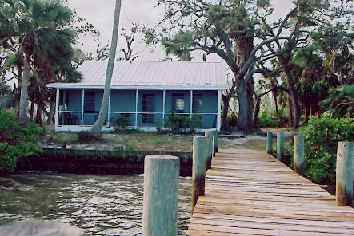I'm
Pretty Sure It's Not Poison Ivy (cont'd)
Cabbage Key, Florida - February 2005
 DAY
3
DAY
3
At Cabbage Key we leased the Tarpon Research station. The original buildings
on Cabbage Key were built in 1929, by Alan Rinehart and Grace Houghton
Rinehart as their winter estate. The Rineharts financed the research
lab in 1940. It’s a rustic place and a good place to study Botany.
Even though it was clear the effect of hurricane Charley remained, the
island was managing to recover. Our study of Botany involves photographing
and identifying 40 vascular and 5 non-vascular plants. Cabbage Key is
a great place to do just that. So was a neighboring island Cayo Costa.
DAY 4
Cayo Costa is a Florida State park where you can find and abundance
of wild life and plant life. We saw osprey, sharks and sea urchins.
We also photographed many different plant species. Cayo Costa is another
island you can only access by boat but it is well worth the effort.
There are secret lagoons, miles of unspoiled beach and acres of wild
Florida. This place allows you to imagine what Native Floridians lived
like. You can camp at Cayo Costa and there are primitive cabins you
can rent, but we chose to stay at cabbage Key.
DAY 5
There are some very good nature trails at Cabbage Key, there is also
something very good at the restaurant here. Magically, between the hours
of 11 & 2 PM hoards of boats bringing people for lunch ascend on
this island. We ate dinner up at the main building but then there is
no parade for dinner, so one of these days we’ll meander over
there at lunch, but today we’re content watching the boats come
and in enjoying our studies on the dock.